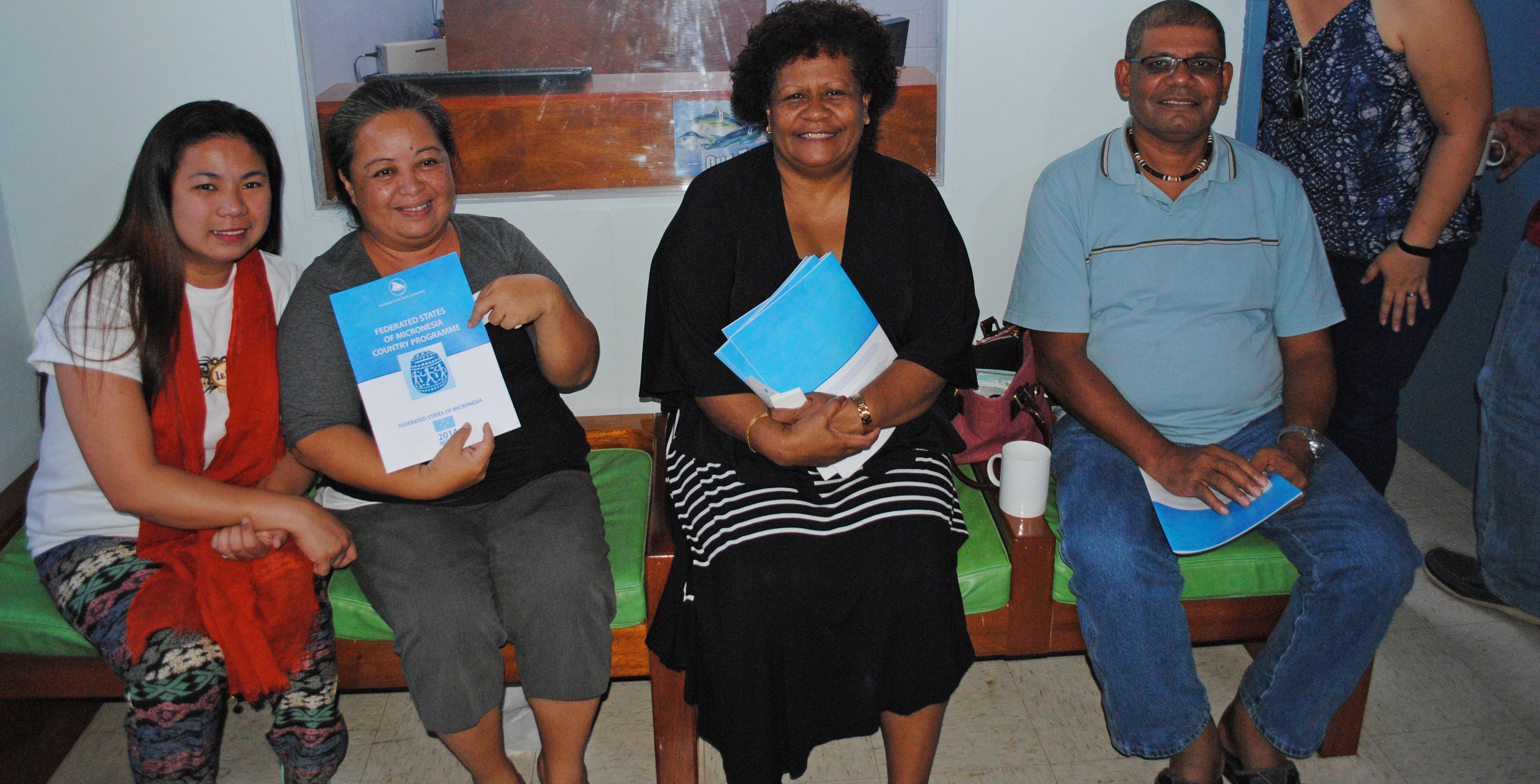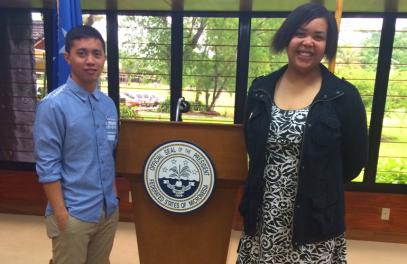Student Spotlights
Education Graduate Students Study Diversity in Pohnpei
Student Spotlights
2/2/2018
Education Graduate Students Study Diversity in Pohnpei

UOG student Annalyn Palacios (left) poses with Dr. Unaisi Nabobo-Baba (center) and
two SPC workers following the interview of staff at the Secretariat of the Pacific
Community.
Chiara Sgambelluri, a theater teacher at Okkodo High School, connected more with her
students with ties to the Federated States of Micronesia following her trip to Pohnpei.
“When I came back, all my FSM students seemed more proud and happy I was in their island,” she said. “It built a better foundation for me and my students.”
Sgambelluri, a recent graduate from the University of Guam with a Masters of Arts in Teaching, said meeting FSM nationals and experiencing their cultures gave her a better understanding of her students, a result shared with her classmates in the Diversity in Education class headed by Dr. Unaisi Nabobo-Baba.
The class traveled to Pohnpei for nine days at the end of March to study key concepts discussed in the classroom.
The purpose of the trip, said John Sarmiento, a creative writing teacher at Tiyan High School, was to take the concepts of diversity—like socio-economics, religion, gender and age—and experience them first-hand in a place that directly affects Guam’s classrooms.
Dr. Nabobo-Baba believes students, especially those at the graduate level, cannot absorb the entirety of the lessons by just reading a book or watching videos in a classroom.
“The fieldtrip idea is really one of the teaching methods that I use as a professor of diversity and multiculturalism and (as) a professor in the School of Education,” she said. “One of the things I feel strongly about is not only the international experience of students, but I also believe what we’re learning in the classroom can benefit from fieldtrips.”
This is would be the fourth fieldtrip Nabobo-Baba has organized during her five years
at UOG. Her first three took students all around the globe to California, Rota and
Fiji. UOG students John Sarmiento (left) and Chiara Sgambelluri pose in the office of Federated
States of Micronesia then-Vice President Alik L. Alik after interviewing him for field
research as part of an assignment for the Diversity in Education masters class.
UOG students John Sarmiento (left) and Chiara Sgambelluri pose in the office of Federated
States of Micronesia then-Vice President Alik L. Alik after interviewing him for field
research as part of an assignment for the Diversity in Education masters class.
“For me the fact that we’re on an island obligates us as faculty—as scholars who believe in scholarship—that when we do teach, we expose our students to a little bit more,” she said.
The students ultimately were the ones that chose the location of the fieldtrip. At first, Sarmiento said, many thought Palau would be a good place to study those key concepts, but looking at the current diversity challenges of Guam’s classrooms and the fact that the College of Micronesia headquarters is located in Pohnpei, the students decided to redirect their focus.
“We felt like it would it would be more of an adventure,” he said. “We knew less about Pohnpei than we did about Palau.”
While in Pohnpei, the students attended the College of Micronesia’s Culture Day and visit a Nahs, or a traditional house where the high chief receives visitors, for a Sakau ceremony.
Guam’s Classrooms
Sarmiento said that in his classroom at Tiyan High School, he’s encountered many situations surrounding diversity in education.
“In my class (one of the) key issues I’ve been facing (is) socio-economics,” he said. “We have a very big population on free lunch. These kids are coming from families that are not as affluent.”
He also noted the cultural differences of his students, which, as an educator, he must take into consideration when leading group discussions or navigating classroom dynamics.
“Cultural differences affect how I have to teach,” Sarmiento said.
He said that’s why he enjoys the discourse in his classes at the UOG School of Education, because teachers with experience from all different backgrounds can get together and talk about solutions to the issues.
“The School of Education has a lot of positivity,” he said. “The good thing about the masters program, a lot of us were temporarily certified, (and) first-hand teachers are all together at a level (to) discuss things that happen in the classroom. We’re still considered rookie teachers, but we have a wealth of experience going to Pohnpei because we’ve been teaching. (The masters program) has given us the opportunity to refine our perspectives and sharpen our teaching philosophy.”
